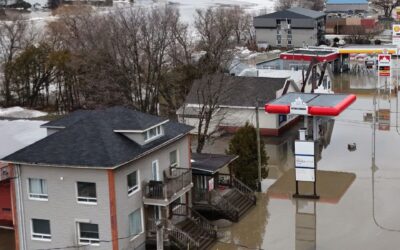A record-breaking winter storm in the southern US caused widespread power outages in the region. Texas was hit hardest, with millions without electricity days after the storm landed. The cost of supplying electricity in the state spiked 10,000 per cent above normal levels. The grid operator deliberately cut power to customers, through rolling blackouts, to prevent the whole grid from collapsing.
Though the Texas crisis is caused by snowy conditions that most Canadians would take in stride, this is still a warning for us. Canada should pay attention.
A crisis of cascading impacts
The massive power outages were triggered by an extreme winter storm, causing both demand- and supply-side impacts in a one-two punch. On one hand, electricity demand for heating rose sharply in cold temperatures. Meanwhile, the supply of that electricity was disrupted, with power plants failing throughout the state.
It’s bad enough that millions have lost heat and light in their homes, but the loss of power has precipitated a cascade of other impacts, underscoring the essential services that electricity powers. Loss of refrigeration and poor road conditions have disrupted COVID-19 vaccination efforts. Impacts on water distribution and treatment have made potable water scarce in certain regions, and boil water advisories have been issued across the state. Food supply chains have been disrupted: millions of dollars worth of milk down the drain because it can’t get processed.
Canada is different from Texas, but we are vulnerable just the same
Sure, Canada is not Texas. The Texan grid is islanded from the rest of the country. Grids across southern Canada are better connected to the main North American grids. Most of Texas’ electricity comes from fossil fuels (natural gas and coal), with a growing minority from wind and solar. In Canada, generation mixes vary across regions, but we tend to rely more on hydropower, which has its own strengths and vulnerabilities.
But don’t be fooled into thinking because Canadians can hack the cold, the Texas situation doesn’t concern us. Just as Texas was blind-sided by “Canadian” weather, what if “Texas”-style heat waves and drought were to hit here? An upcoming Institute report in fact finds that in Canada, extreme summer weather can both tax infrastructure that supplies electricity and drive up peak electricity demand—sound familiar?
“Long tail” (low likelihood, high impact) events, of various types, will only become more frequent with climate change. Canada has seen its share of such events: ice storms in the east, wildfires in the west, and floods everywhere in between. Climate hazards will vary by region, with more extreme precipitation, changing water availability, and more frequent heat waves, which could each impact Canada’s electricity system.
“Hardening” infrastructure is just one part of the solution
The events in Texas are showing that infrastructure needs to be built stronger to withstand extreme conditions so that, for instance, gas wells and wind turbines don’t freeze in cold temperatures. But targeted fixes to “harden” infrastructure are just one part of the solution. Since we don’t know where or when disaster may strike, the entire system should be made more resilient, including allowing certain parts to fail but bounce back.
- Build up reinforcements: Stronger interconnections can act as a lifeline during times of need, the lack of which was the Achilles’ heel for Texas. Our provincial grids are tied to the continental system, though border provinces tend to be better connected to their southern states than with their domestic neighbours. Building out storage is another way of ensuring back-up reserves are on hand when needed.
- Re-think electricity system design: Supporting decentralized electricity systems based on diverse generation sources would help put our eggs in different baskets. If one plant or energy type goes down, the entire system doesn’t. This is true for off-grid communities too. For instance, Gull Bay First Nation in northern Ontario has set up a solar-based microgrid to become more energy self-sufficient and reduce reliance on diesel.
It’s also important to re-consider whether market design is working to create the right incentives to build resilience. Whether it’s the (more) deregulated markets in Alberta and Ontario, or the vertically-integrated model in many other provinces, the market should ideally incentivize or at least not create barriers for regulators, utilities, and consumers to build resilience.
- Don’t forget the demand side: It’s easy to blame the failure of power plants and transmission lines for outages, but improving the efficiency of homes and businesses—such as improved insulation and more efficient appliances—means less demand, and ultimately, less vulnerability to disruption. Allowing demand to respond in real-time can encourage conservation or load shifting when supply is scarce, but would require greater roll-out of smart grid infrastructure and re-thinking market design in many Canadian electricity systems.
- Align with low-carbon objectives: As Canada modernizes its aging grids, resilience should be built up alongside the pursuit of other objectives, notably decarbonization. Luckily, many of the measures listed in this blog can help achieve both: greater interconnections and storage can help balance higher shares of solar and wind. Smart grids and energy efficiency promote more efficient use of energy resources. Of course, these will need to be balanced with affordability and public acceptability. No silver bullet exists, but there are win-wins to be had.
Infrastructure should be built for the future, not the past
The events in Texas have shown the dire consequences of how freak weather events—and lack of planning for them—can leave millions of people in the freezing dark. Science tells us climate change will make these “long tail” events more common. As a basic starting point, electricity planning should consider conditions of the future, not the past. As we decarbonize our grids, we should make them more resilient.
Stayed tuned for an upcoming report on how climate change can impact infrastructure systems, including electricity demand and distribution, in Canada.





